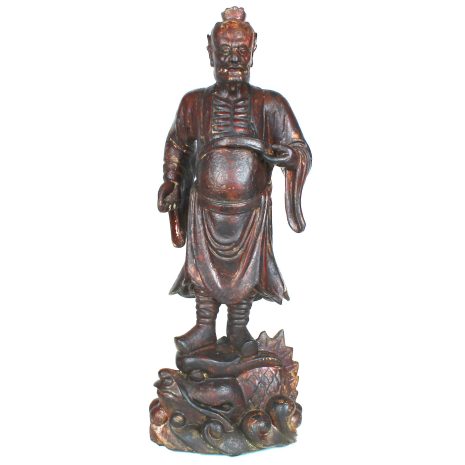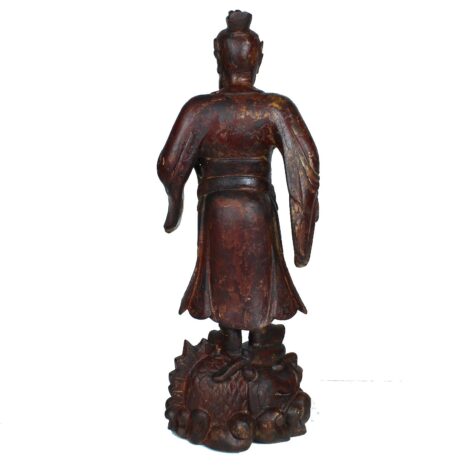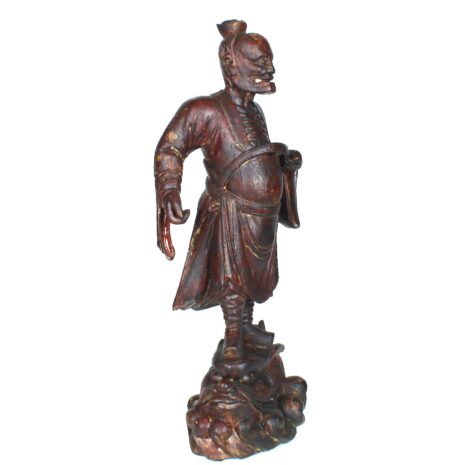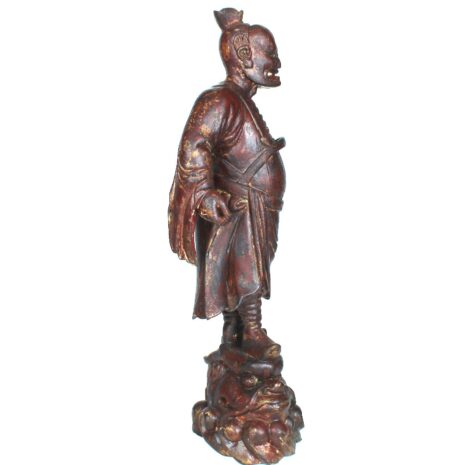Antique Taoist Literature God on Dragon, China (16615)
Original price was: $1,095.00.$795.00Current price is: $795.00.
H: 15.5″ W: 5.5″ D: 4.5″| CALL 213-568-3030 OR EMAIL [email protected] FOR SHIPPING.
God of Literature, Books and Writing, Education, Learning and Examinations, Wen Chang is the patron saint of scholars. Thin, surly, demon like with exposed ribs and facial distortions, he stands on a dragon’ head among waves. Unique wonderful carving that would look spectacular on a desk.
Description
Initially linked to the Big Dipper in Chinese mythology, Wen Chang is worshipped in the 3rd and 8th months as the God of several spheres: Literature, Books and Writing, Education, Learning and Examinations and is the patron saint of scholars. As one of the revered Taoist deities, hero and house-gods closely associated with Confucianism, he is syncretic – a blend of many religious traditions includong Buddhism and Popular Religion.
He is associated with the parable of a carp struggling to swim upstream who morphs into a dragon and reaches the Dragon Gate atop a waterfall, a metaphor for the rigors needed by scholars to pass imperial civil service examinations that leads to an influential post, security and wealth in the state bureaucracy. Excellence in scholarship was considered to be the main determinate of one’s rank and social status in Confucian society. Dragons, one of China’s most propitious, beautiful and friendly mythical-animals are the greatest divine creatures on earth, the ultimate symbols of the forces of Nature that bring abundance, prosperity, and good fortune. Wen Chang may also be shown holding a writing brush or rice measure with one leg kicking back, derived from the combination of Chinese characters making up his name that means “demon,” “dipper or bushel measure,” and “kick.”
He is, as here, often presented as a tall, extremely thin, surly, demon like image with ribs showing and facial distortions who stands firmly on the head of a dragon (lung) among waves. He holds his belt as a sign of status ” Temples dedicated to him can be found in most cities in China. As one of many “household gods” Chinese relied on to attain wealth, health, long life, and good fortune, statues of Wen Chan such as this were owned and displayed by a wide range of literary persons including students, government officials, writers and calligraphers.
This piece is in excellent condition, the carving is done using consummate skills, and it is full of finely modelled details. There are only a few surface losses, and this wonderful piece has a covered in a fine patina despite its old age and long use.
Sources:
Minneapolis Institute of Art, “Kui Xing (God of Literature),” 2021 https://collections.artsmia.org/art/5798/kui-xing-china E.T.C. Werner, Myths and Legends of China, Mineola, Dover Publications, 1994.
Additional information
| Weight | 7 lbs |
|---|---|
| Dimensions | 18 × 12 × 6 in |
| Place of Origin | China |
| Period | Antique, Qing Dynasty |
| Date | 18th century |
| Materials and Technique | Wood |
| Dimensions (inches) | Ht:15.5” W: 5.5” D: 4.5” |
| Dimensions (metric) | Ht: 39.37cm W: 13.97cm D: 11.43cm |
| Weight | 1 lb 9oz |
| Condition | Excellent, fine patina demonstrating age and use |
| Item Number | 16615PBRK |
| Shipping Box Size |












